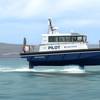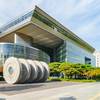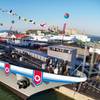Feature: Conrad Building New Ferry for AMHS
By Larry Pearson
The Alaska Marine Highway System has become very active building ferries for the State of Alaska. Much of the recent attention has gone to the pair of 235-ft. fast ferries Derecktor Shipyards has under construction at their new Bridgeport, Conn., shipyard that can carry 250 people and 35 autos at speeds in excess of 30 knots. But since February of this year, Conrad Shipyard LLC, Morgan City, La. has been building a 181- x 50-ft. auto/passenger ferry for use in the Southeastern part of the state. It will run from Ketchikan to the Island of Annette a private reservation for the Metlakatla Indian Community. There are approximately 2,100 people on the Island, located 18 miles southeast of Ketchikan.
"The route from Ketchikan to Metlakatla will be 16.5 miles when the Lituya takes over the run in the spring of 2004," said Tom Atwood, a marine engineer with State of Alaska DOT and Marine Facilities. Atwood, the project manager for the ferry, heads a team of three people from Alaska DOT that also includes Lance Ohmer, a chief engineer and head of inspection on the Lituya project and Cisco Flores, assistant project manager.
"A new terminal south of the present terminal will reduce the distance to just over 11 miles and when a new road is completed on the island the final distance will be just 3.5 miles" Atwood said. It will be 3-4 years before the route is cut to 3.5 miles Atwood estimates.
Atwood says the ferry will make one round trip per day at startup during daylight ours only. "When the distance between the two points in 3.5 miles, we can then begin hourly service," Atwood said.
In the early design stages, the state was thinking of a traditional double-ended ferry. "But the Islanders didn't like it and we found that a vessel shaped much like a North Sea oil field supply boat was preferable considering the sea states often encountered on the route," Atwood added.
Coastwise Engineering of Juneau, Alaska handled preliminary design and the detailed design was by Jensen Maritime Consultants, Inc. of Seattle, Wash. Conrad was deeply involved with this project from the beginning. "We didn't just throw out a price in response to the bid documents," said Steve Berthold, marketing manager for Conrad. Conrad was involved in the earliest stages of the project suggesting modifications of the specs to make the job more "shipyard friendly."
"Prior to issuance of the bid package, we toured several shipyards and found that Conrad expressed the most interest in building the ferry," Atwood said.
Many of the Alaskan ferries have covered areas for cars and trucks but Atwood believes the design of this vessel will minimize water spray on the main deck.
The design places the superstructure far forward so that the vehicle parking area will measure 130 ft. long and vehicles can utilize almost the ship's entire 50-ft. beam.
At the Ketchikan terminal vehicles will load and exit ant the stern. On the Metlakatla dock, the vessel will side load and side discharge. The vessel is designed for 18 cars or less automobiles when heavy trucks or construction machinery is a part of the load mix. The side-loading ramp is on the starboard side of the vessel and is 20 ft. wide and is carried internally on the ferry. The stern ramp is 18 ft. wide.
The deck has tie downs to anchor trucks or other outsize equipment and two airline-type evacuation slides to quickly and safely allow passengers to exit the ferry directly into a lifeboat.
At the forward end of the main deck where it meets the superstructure there are provisions for passenger luggage and even a small kennel.
The superstructure will have two passenger lounges capable of holding 149 persons, per Subchapter "T" rules. An elevator that is fully ADA compliant serves the two passenger decks and each deck has specific areas designated for wheel chairs. "Seating capacity in the two passengers lounges is 65 plus four ADA positions," Atwood reported.
The main deck passenger cabin has a refrigerated water fountain and vending machines against an A-60 wall far forward. Propulsion power for the ferry comes from a pair of Caterpillar 3508 B engines, rated at 1,000 hp at 1,800 rpm. These engines work into Twin Disc gears and spin three-bladed 72-in. diameter props with a 60-in. pitch. Vessel speed is estimated at 13-14 knots. The vessel is not ice classed since the waters do not have winter ice.
Lituya will be equipped with three rudders to assist backing into dock without the use of the bow thruster.
Electrical power is via a Caterpillar 3304 turbocharged diesel generator set producing 105 kW of electricity. A Caterpillar 3406 C diesel powers the Thrustmaster bow thruster. This engine can also be used as a backup diesel generator set rated at 320 kW.
The vessel is equipped with a fire monitor located on the 01 deck. The monitor has a fire main pump and a fire monitor pump in the hull. The monitor is used to contain any incident on the auto deck. In addition to the fire monitor mounted above the main deck, there is a dry chemical and foam self-contained system on deck to contain fire and any other incident such as leaking fuel.
"On occasion, we will use the ferry for special runs carrying fuel trucks for example," Atwood said. "When we are carrying any hazardous cargo, we have to have these safety systems on board," Atwood added.
An electric crane is also a part of the safety package. "This is used for man overboard situations. The crane will pickup a life raft from a metal box on deck and lower it near the person overboard.
This contract has also been the galvanizing force behind infrastructure changes at Conrad. "From first discussions with the owner to successful completion of sea trials, Conrad has made major changes in the way we handle a project of this magnitude internally," said Berthold. "Our infrastructure changed with the complexity of this contract and the specific needs of the owner," he added.
"For example, the Alaska Marine Highway System insists that we "Buy American' meaning that every piece of steel used on this project is stamped with a "heat number", so it origin can be traced back to the mill that produced it," Berthold added.
It is details such as that, plus controlling the work of numerous subcontractors, cost detail and other factors that led Conrad to upgrade its computer system and revamp its internal project management. "We had installed the new Oracle computer system before this project, but the Alaskan ferry was the first opportunity to utilize it fully," Berthold said.
Conrad also formed an experienced project team to allow the work to proceed quickly and efficiently. Tim Gray is the lead project manager with A.J. Blanchard and Brian Barbier also deeply involved with the management of the construction.
Conrad has been expanding in the Amelia area of late. Amelia, La. is a short five-mile drive from Morgan City. A few months ago Conrad opened a deepwater repair facility and moved their huge 280- x 140-ft. dry dock to the facility along with two other dry docks. Large deepwater supply boats are now docking there for repairs and other work. Recently the HOS Deepwater was in one of the slips for tank cleaning and the Harvey Explorer was in the large dry dock for repairs.
Conrad recently announced the purchase of land along U.S. 90 with direct water access to build an aluminum repair, fabrication and conversion shipyard. A 37,000 sq. ft. two-bay building will be erected on the property along with six overhead cranes and a 300-ton travel lift.












